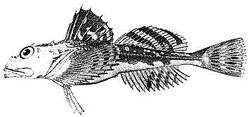
A sculpin is a type of fish that belongs to the superfamily Cottoidea in the order Scorpaeniformes. As of 2006, this superfamily contains 7 families, 94 genera, and 387 species.

The Scorpaeniformes are a diverse order of ray-finned fish, including the lionfishes and sculpins, but have also been called the Scleroparei. It is one of the five largest orders of bony fishes by number of species, with over 1,320.
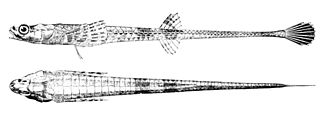
Agonidae is a family of small, bottom-dwelling, cold-water marine fish. Common names for members of this family include poachers, Irish lords, sea ravens, alligatorfishes, starsnouts, hooknoses, and rockheads. They are notable for having elongated bodies covered by scales modified into bony plates, and for using their large pectoral fins to move in short bursts. The family includes about 59 species in some 25 genera, some of which are quite widespread.
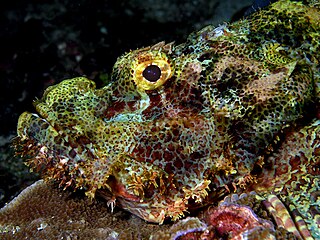
The Scorpaenidae are a family of mostly marine fish that includes many of the world's most venomous species. As their name suggests, scorpionfish have a type of "sting" in the form of sharp spines coated with venomous mucus. The family is a large one, with hundreds of members. They are widespread in tropical and temperate seas but mostly found in the Indo-Pacific. They should not be confused with the cabezones, of the genus Scorpaenichthys, which belong to a separate, though related, family, Cottidae.
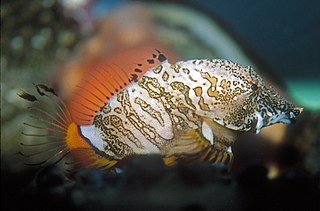
Rhamphocottus is a genus of marine ray-finned fishes belonging to the family Rhamphocottidae. These fishes are known as grunt sculpins. The grunt sculpins are found in the North Pacific Ocean.
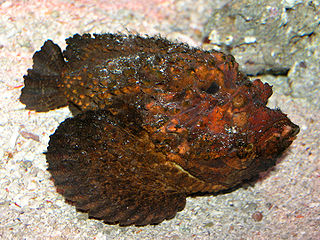
Synanceiinae is a subfamily of venomous ray-finned fishes, waspfishes, which is classified as part of the family Scorpaenidae, the scorpionfishes and their relatives. These fishes are found in the Indo-Pacific oceans. They are primarily marine, though some species are known to live in fresh or brackish waters. The various species of this family are known informally as stonefish, stinger, stingfish and ghouls. Its species are known to have the most potent neurotoxins of all the fish venoms, secreted from glands at the base of their needle-like dorsal fin spines. The vernacular name, stonefish, for some of these fishes derives from their behaviour of camouflaging as rocks. The type species of the family is the estuarine stonefish.

Chironemus is a genus of marine ray finned fish, commonly known as kelpfishes, belonging to the family Chironemidae. They are found in the temperate waters of the Southern Pacific Ocean.

Apistinae, the wasp scorpionfishes, is a subfamily of venomous, marine ray-finned fishes belonging to the family Scorpaenidae, the scorpionfishes and related species. These fishes are native to the Indian Ocean and the western Pacific Ocean.

Myoxocephalus is a genus of marine ray-finned fishes belonging to the family Cottidae, the typical sculpins. They are found in the norther Pacific, Arctic and Atlantic Oceans, with a few species in lakes.

The Microcanthinae, commonly known as footballers, mados, stripeys, and moonlighters, are a subfamily of the sea chubs, a family of marine ray-finned fish in the order Perciformes.

The sailfin sculpin is a species of marine ray-finned fish belonging to the subfamily Hemitripterinae of the family Agonidae. This sculpin is found in the eastern Pacific Ocean from St. Lawrence Island, Alaska to San Miguel Island off southern California. Named for its elongated, sail-like first dorsal fin, the sailfin sculpin is a popular subject of public aquaria; it is of no interest to commercial fishery.

Blepsias is a genus of marine ray-finned fishes belonging to the family Agonidae, the poachers and related fishes. These fishes are found in the coastal northern Pacific Ocean from Japan to California.

Nautichthys is a genus of marine ray-finned fishes, sculpins, belonging to the subfamily Hemitripterinae which is part of the family Agonidae. These fishes are found in the North Pacific Ocean.

Minous, is a genus of marine ray-finned fishes, it is the only genus in the tribe Minoini, one of the three tribes which are classified within the subfamily Synanceiinae within the family Scorpaenidae, the scorpionfishes and their relatives. They are commonly known as stingfishes. They are found in the Indo-West Pacific.

Blepsias cirrhosus, the silverspotted sculpin, is a species of sculpin belonging to the subfamily Hemitripterinae of the family Agonidae. This species is found the northern Pacific Ocean from the Sea of Japan and Alaska to San Miguel Island off southern California.

Blepsias bilobus, the crested sculpin, is a species of sculpin belonging to the subfamily Hemitripterinae of the family Agonidae. This species is found in the North Pacific Ocean.
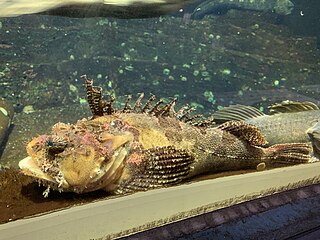
Hemitripterus villosus, the sea raven, is a species of marine ray-finned fish belonging to the subfamily Hemitripterinae of the family Agonidae. The sea raven is found in the northwestern Pacific Ocean off the coast of Russia and Japan.

The Serraninae is a subfamily of perciform ray-finned fishes in the family Serranidae. It is made up of ten genera and 87 species.
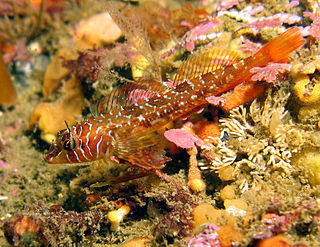
Jordaniidae is a small family of marine ray-finned fishes belonging to the order Scorpaeniformes. These fishes are found in the eastern North Pacific Ocean.

Hypsagoninae is a subfamily of marine ray-finned fishes belonging to the family Agonidae, part of the sculpin superfamily Cottoidea. These fishes are found in the North Pacific Ocean.


















